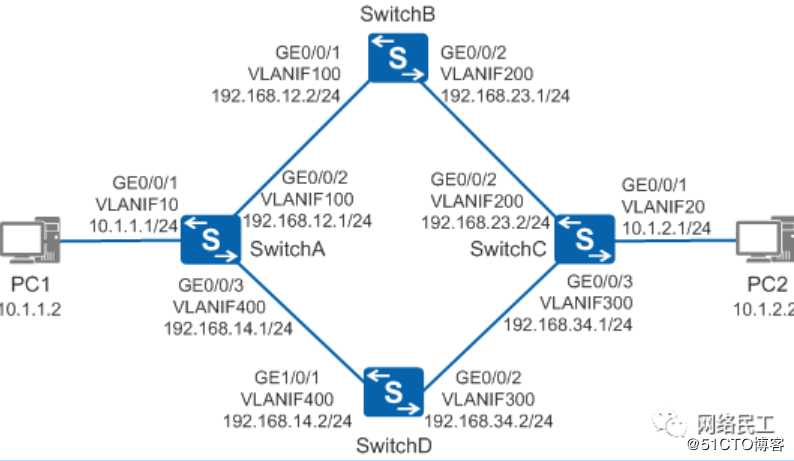静态路由实现路由负载分担
Posted
tags:
篇首语:本文由小常识网(cha138.com)小编为大家整理,主要介绍了静态路由实现路由负载分担相关的知识,希望对你有一定的参考价值。
静态路由简介

扫描二维码关注微信公众号:网络民工 获取更多内容
静态路由是一种需要管理员手工配置的特殊路由。静态路由比动态路由使用更少的带宽,并且不占用CPU资源来计算和更新路由。但是当网络发生故障或者拓扑发生变化后,静态路由不会自动更新,必须手动重新配置。静态路由有5个主要的参数:目的地址和掩码、出接口和下一跳、优先级。
使用静态路由的好处是配置简单、可控性高,当网络结构比较简单时,只需配置静态路由就可以使网络正常工作。在复杂网络环境中,还可以通过配置静态路由改进网络的性能,并且可以为重要的应用保证带宽。
配置注意事项
· 一般情况下两个设备之间的通信是双向的,因此路由也必须是双向的,在本端配置完静态路由以后,请不要忘记在对端设备上配置回程路由。
· 在企业网络双出口的场景中,通过配置两条等价的静态路由可以实现负载分担,流量可以均衡的分配到两条不同的链路上;通过配置两条不等价的静态路由可以实现主备份,当主用链路故障的时候流量切换到备用链路上。
组网需求
如图1所示,PC1和PC2通过4台Switch相连,从拓扑图中可以看出,数据从PC1到PC2有两条路径可以到达,分别是PC1-SwitchA-SwitchB-SwitchC-PC2和PC1-SwitchA-SwitchD-SwitchC-PC2,为了有效利用链路,要求从PC1到PC2的数据流平均分配到两条链路上,而且当一条链路故障之后数据流自动切换到另一条链路上去。
说明:
请确保该场景下互联接口的STP处于未使能状态。因为在使能STP的环形网络中,如果用交换机的VLANIF接口构建三层网络,会导致某个端口被阻塞,从而导致三层业务不能正常运行。

图1 配置静态路由实现路由负载分担组网图
配置思路
采用如下的思路配置静态路由实现路由负载分担:
-
创建VLAN并配置各接口所属VLAN,配置各VLANIF接口的IP地址。
-
配置数据流来回两个方向的静态路由。
- 在各主机上配置IP地址和默认网关。
操作步骤
- 配置各接口所属VLAN
配置SwitchA。SwitchB、SwitchC和SwitchD的配置与SwitchA类似。
<HUAWEI> system-view
[HUAWEI] sysnameSwitchA
[SwitchA] vlanbatch 10 100 400
[SwitchA] interfacegigabitethernet 0/0/1
[SwitchA-GigabitEthernet0/0/1]port link-type access
[SwitchA-GigabitEthernet0/0/1]port default vlan 10
[SwitchA-GigabitEthernet0/0/1]quit
[SwitchA] interfacegigabitethernet 0/0/2
[SwitchA-GigabitEthernet0/0/2]port link-type trunk
[SwitchA-GigabitEthernet0/0/2]port trunk allow-pass vlan 100
[SwitchA-GigabitEthernet0/0/2]quit
[SwitchA] interfacegigabitethernet 0/0/3
[SwitchA-GigabitEthernet0/0/3]port link-type trunk
[SwitchA-GigabitEthernet0/0/3]port trunk allow-pass vlan 400
[SwitchA-GigabitEthernet0/0/3]quit
- 配置各VLANIF接口的IP地址
配置SwitchA。SwitchB、SwitchC和SwitchD的配置与SwitchA类似。
[SwitchA]interface vlanif 10
[SwitchA-Vlanif10]ip address 10.1.1.1 24
[SwitchA-Vlanif10]quit
[SwitchA]interface vlanif 100
[SwitchA-Vlanif100]ip address 192.168.12.1 24
[SwitchA-Vlanif100]quit
[SwitchA] interfacevlanif 400
[SwitchA-Vlanif400]ip address 192.168.14.1 24
[SwitchA-Vlanif400]quit
- 配置PC1–PC2的去程的静态路由
配置SwitchA,配置两条等价的静态路由,下一跳分别指向SwitchB和SwitchD,这样就能实现去程的流量的负载分担。
[SwitchA] iproute-static 10.1.2.0 24 192.168.12.2
[SwitchA] iproute-static 10.1.2.0 24 192.168.14.2
配置SwitchB。
[SwitchB] iproute-static 10.1.2.0 24 192.168.23.2
配置SwitchD。
[SwitchD] iproute-static 10.1.2.0 24 192.168.34.1
- 配置PC1–PC2的回程的静态路由
配置SwitchC,配置两条等价的静态路由,下一跳分别指向SwitchB和SwitchD,这样就能实现回程流量的负载分担。
[SwitchC] iproute-static 10.1.1.0 24 192.168.23.1
[SwitchC] iproute-static 10.1.1.0 24 192.168.34.2
配置SwitchB。
[SwitchB] iproute-static 10.1.1.0 24 192.168.12.1
配置SwitchD。
[SwitchD] iproute-static 10.1.1.0 24 192.168.14.1
- 配置主机
配置主机PC1的IP地址为10.1.1.2/24,默认网关为10.1.1.1;配置主机PC2的IP地址为10.1.2.2,默认网关为10.1.2.1。
- 验证配置结果
#查看SwitchA的IP路由表。
[SwitchA] displayip routing-table
Route Flags: R -relay, D - download to fib
Routing Tables:Public
Destinations : 9 Routes : 10
Destination/Mask Proto Pre Cost Flags NextHop Interface
10.1.1.0/24 Direct 0 0 D 10.1.1.1 Vlanif10
10.1.1.1/32 Direct 0 0 D 127.0.0.1 Vlanif10
10.1.2.0/24 Static 60 0 RD 192.168.12.2 Vlanif100
Static 60 0 RD 192.168.14.2 Vlanif400
127.0.0.0/8 Direct 0 0 D 127.0.0.1 InLoopBack0
127.0.0.1/32 Direct 0 0 D 127.0.0.1 InLoopBack0
192.168.12.0/24 Direct 0 0 D 192.168.12.1 Vlanif100
192.168.12.1/32 Direct 0 0 D 127.0.0.1 Vlanif100
192.168.14.0/24 Direct 0 0 D 192.168.14.1 Vlanif400
192.168.14.1/32 Direct 0 0 D 127.0.0.1 Vlanif400
从SwitchA的IP路由表中可以看出,到达10.1.2.0/24这个网段有两条等价路由,这种情况下数据流将会平均分配到两条不同的链路上,即实现流量的负载分担。
配置文件
· SwitchA的配置文件
#
sysname SwitchA
#
vlan batch 10 100400
#
interface Vlanif10
ip address 10.1.1.1 255.255.255.0
#
interface Vlanif100
ip address 192.168.12.1 255.255.255.0
#
interface Vlanif400
ip address 192.168.14.1 255.255.255.0
#
interface GigabitEthernet0/0/1
port link-type access
port default vlan 10
#
interface GigabitEthernet0/0/2
port link-type trunk
port trunk allow-pass vlan 100
#
interface GigabitEthernet0/0/3
port link-type trunk
port trunk allow-pass vlan 400
#
ip route-static10.1.2.0 255.255.255.0 192.168.12.2
ip route-static10.1.2.0 255.255.255.0 192.168.14.2
#
return
· SwitchB的配置文件
#
sysname SwitchB
#
vlan batch 100 200
#
interface Vlanif100
ip address 192.168.12.2 255.255.255.0
#
interface Vlanif200
ip address 192.168.23.1 255.255.255.0
#
interface GigabitEthernet0/0/1
port link-type trunk
port trunk allow-pass vlan 100
#
interface GigabitEthernet0/0/2
port link-type trunk
port trunk allow-pass vlan 200
#
ip route-static10.1.1.0 255.255.255.0 192.168.12.1
ip route-static10.1.2.0 255.255.255.0 192.168.23.2
#
return
· SwitchC的配置文件
#
sysname SwitchC
#
vlan batch 20 200300
#
interface Vlanif20
ip address 10.1.2.1 255.255.255.0
#
interface Vlanif200
ip address 192.168.23.2 255.255.255.0
#
interface Vlanif300
ip address 192.168.34.1 255.255.255.0
#
interface GigabitEthernet0/0/1
port link-type access
port default vlan 20
#
interface GigabitEthernet0/0/2
port link-type trunk
port trunk allow-pass vlan 200
#
interface GigabitEthernet0/0/3
port link-type trunk
port trunk allow-pass vlan 300
#
ip route-static10.1.1.0 255.255.255.0 192.168.23.1
ip route-static10.1.1.0 255.255.255.0 192.168.34.2
#
return
· SwitchD的配置文件
#
sysname SwitchD
#
vlan batch 300 400
#
interface Vlanif300
ip address 192.168.34.2 255.255.255.0
#
interface Vlanif400
ip address 192.168.14.2 255.255.255.0
#
interface GigabitEthernet0/0/1
port link-type trunk
port trunk allow-pass vlan 400
#
interface GigabitEthernet0/0/2
port link-type trunk
port trunk allow-pass vlan 300
#
ip route-static10.1.1.0 255.255.255.0 192.168.14.1
ip route-static10.1.2.0 255.255.255.0 192.168.34.1
#
return
扫描二维码关注微信公众号:网络民工 获取更多内容
以上是关于静态路由实现路由负载分担的主要内容,如果未能解决你的问题,请参考以下文章